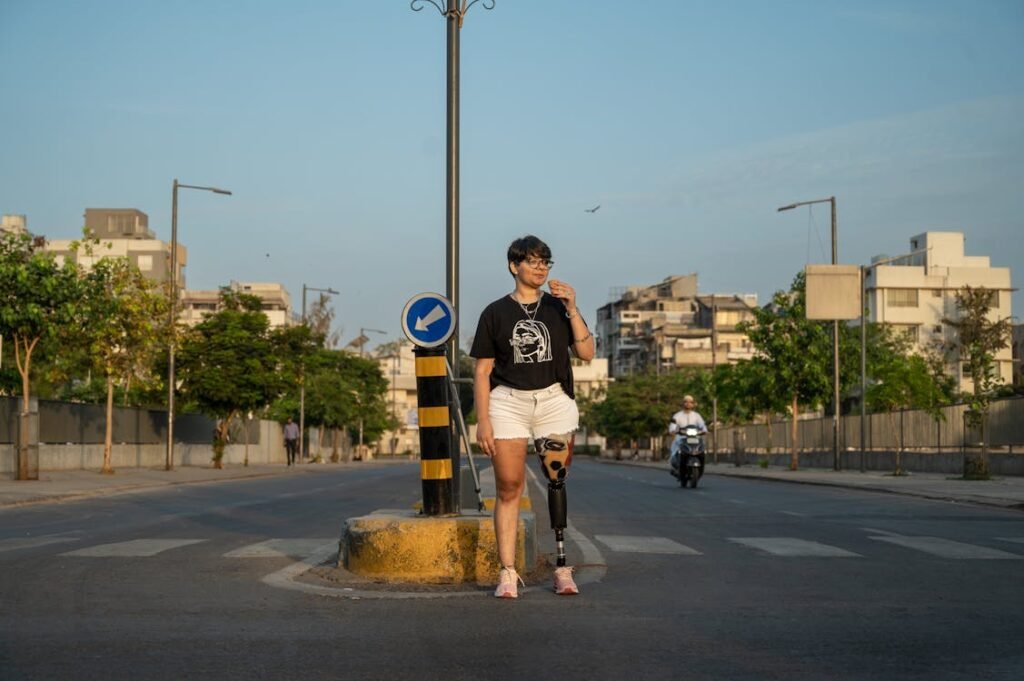When someone loses a limb, getting a prosthetic is a big step. But it’s not just about having something that looks like a leg or arm. What truly matters is how well that prosthetic works with the body. And one of the most important parts of making it work is something many people don’t talk about: alignment.
Alignment is about how the prosthetic is set up and how it fits with your body. It’s the foundation of how you walk, stand, move, and even how your joints feel. If the alignment is off—even by a little—it can cause pain, poor balance, and even long-term damage to your body. On the other hand, when a prosthetic is aligned the right way, it feels natural. You walk better. You feel more stable. Your joints stay healthier for longer.
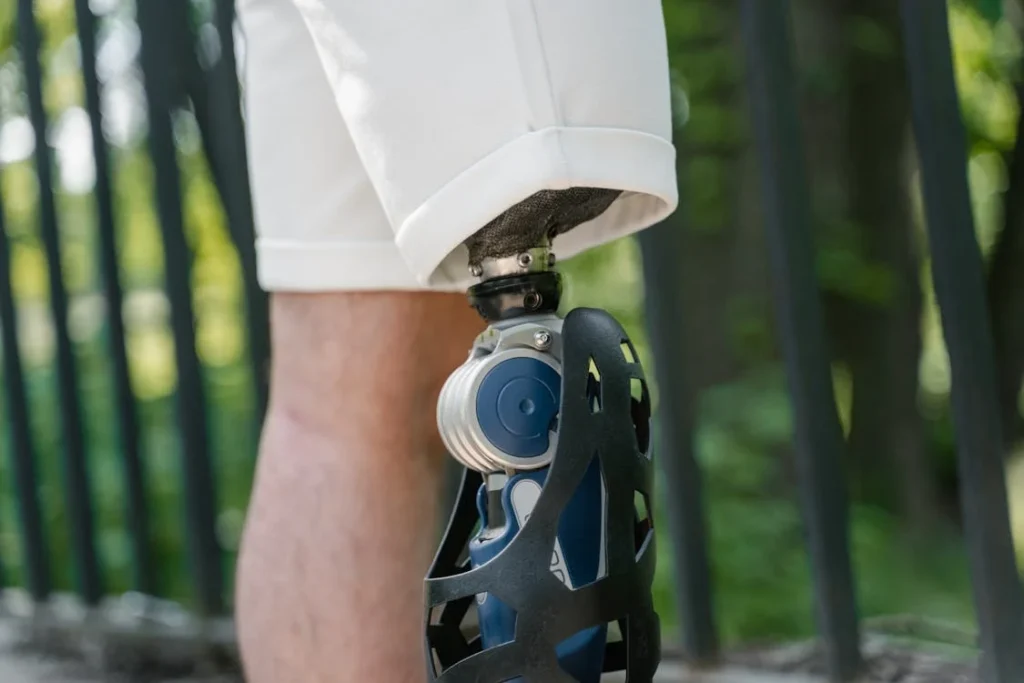
Understanding Prosthetic Alignment
What Alignment Means in Prosthetics
Prosthetic alignment is all about the way a prosthetic limb is positioned and adjusted in relation to the rest of the body. This might sound like a technical detail, but it plays a major role in how someone moves.
The way the socket is tilted, the height of the prosthetic, the angle of the foot or hand component—all these tiny adjustments can change the user’s posture, comfort, and movement.
Every person’s body is different. Even two people with similar amputations may need very different alignments. That’s because alignment depends on things like muscle strength, joint flexibility, weight distribution, and the way a person naturally moves.
A prosthetist must take all of this into account to make sure the prosthetic works with the body, not against it.
When alignment is done right, the prosthetic becomes an extension of the body. The user walks more smoothly, experiences fewer aches and pains, and feels more in control of their balance.
But when it’s done wrong, even by a few millimeters, it can throw everything off. That’s why alignment is never a one-size-fits-all situation. It needs careful attention, regular check-ins, and adjustments over time.
The Role of the Prosthetist
The prosthetist plays a critical role in alignment. During the fitting process, they look at how the person walks and stands. They check whether the foot hits the ground properly, whether the knees bend in a natural way, and whether the shoulders and hips are even. If anything looks off, they make adjustments.
Sometimes alignment changes are very small. A slight tilt of the foot or a tiny change in the socket angle can make a big difference. These changes are often made during a walking trial, where the user walks while being observed.
The prosthetist watches the body’s movement closely and adjusts as needed. This process may take a few sessions, but it’s worth it for long-term comfort and health.
Prosthetists also use tools and technology to help with alignment. Laser levels, gait analysis software, and pressure sensors help them fine-tune the setup. But technology is just part of the process.
The most important piece is listening to the user—how they feel, what’s comfortable, and what’s not. Communication between the prosthetist and the user is key to getting alignment right.
Static vs. Dynamic Alignment
There are two parts to alignment: static and dynamic. Static alignment is about how the prosthetic fits when the person is standing still. The goal here is balance. Both sides of the body should feel equal, and the person should be able to stand without leaning too much in any direction.
Dynamic alignment, on the other hand, is about movement. It focuses on how the prosthetic performs while walking, climbing stairs, or doing daily activities. This is often where the real challenges show up.
A prosthetic might feel fine when standing still but cause problems when the person starts to move. That’s why dynamic alignment is just as important, if not more, than static alignment.
Getting both parts right takes skill, patience, and experience. It also requires time. People change over weeks and months—their body adapts, muscles grow stronger or weaker, and habits shift.
That means alignment might need to be re-checked and re-adjusted regularly. It’s not a one-time task, but an ongoing part of living with a prosthetic.
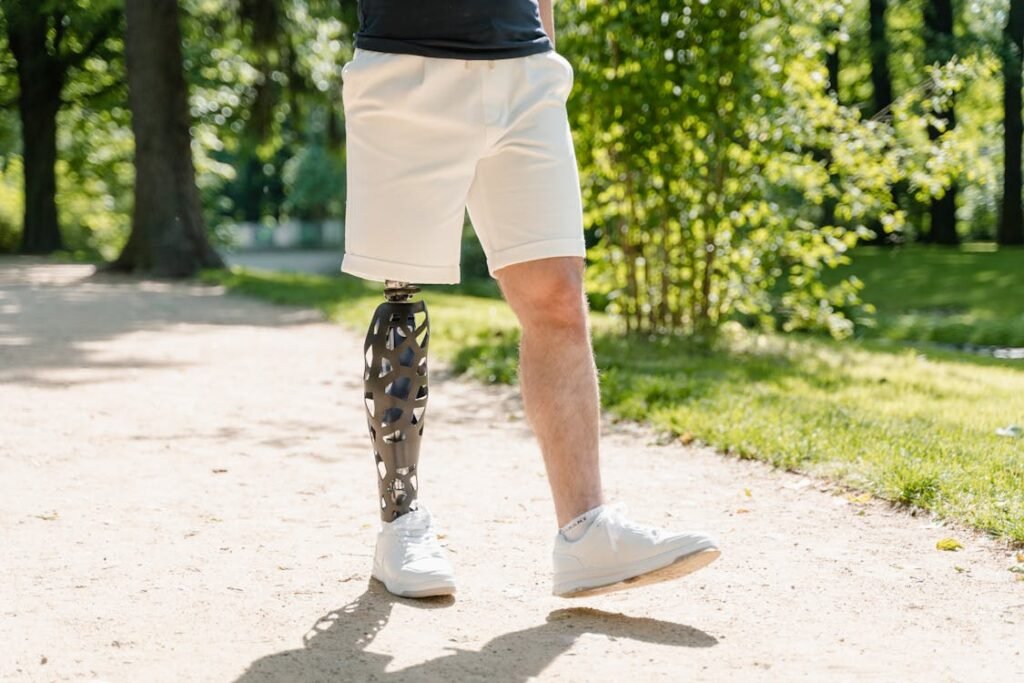
How Alignment Affects Gait
The Basics of Gait
Gait is simply the way a person walks. It may seem like a simple action, but it’s actually a very complex process. Each step involves the brain, muscles, bones, and joints working together.
When someone uses a prosthetic limb, especially a lower-limb one, the entire process of walking changes. The body has to relearn how to take each step. That’s where alignment becomes critical.
A well-aligned prosthetic helps the user walk in a way that feels close to natural. It allows smooth heel-to-toe motion, supports weight evenly, and helps the knee and hip move comfortably.
When alignment is off, the gait becomes awkward. The person may start limping, leaning to one side, or swinging their leg around instead of stepping straight. These changes might feel small at first but can grow worse over time.
Walking with poor alignment can lead to patterns that strain the body. For example, if the prosthetic leg is too long, the person might have to hike their hip or swing their leg out to make a step.
If it’s too short, they might drop the hip or lean forward unnaturally. These movements shift the load to other parts of the body and throw off balance.
How Gait Impacts Long-Term Health
When someone walks with a poor gait for a long time, it can lead to wear and tear on the joints. The knee, hip, and lower back take on extra pressure to make up for the uneven movement. Over time, this can lead to pain, joint damage, and even arthritis.
People often don’t realize this is happening because the body adjusts slowly. The discomfort might come gradually. But by the time it becomes serious, it may already be affecting daily life.
Simple things like walking around the house or getting out of a chair can become painful. In some cases, poor gait can also increase the risk of falling, which adds another layer of risk, especially for older users.
One of the clearest signs of misalignment is when the user starts avoiding certain activities. They may stop walking long distances, hesitate to go out, or feel nervous on uneven surfaces.
These changes affect not only physical health but mental well-being too. The less someone moves, the harder it becomes to stay active and confident.
That’s why good alignment is more than just a technical adjustment—it’s a path to better movement, comfort, and quality of life.
Training the Body with Proper Alignment
After a prosthetic is aligned correctly, the next step is helping the body get used to it. Even with a perfect fit, the muscles and brain need time to adjust. This is where gait training and rehab play a big role.
Many users benefit from working with a physical therapist who understands prosthetic movement. Through guided practice, the person learns to walk with a smooth rhythm, shift weight properly, and build strength where it’s needed.
Walking with a prosthetic is a learned skill. At first, it might feel strange or unstable. But with regular training and good alignment, the user begins to trust their body again.
They start walking more naturally. Their posture improves. They move with more ease and less effort. And most importantly, they gain confidence with each step.
Some rehab programs now use tools like mirrors, treadmills, or video feedback to help users see how they walk. These tools allow them to spot small issues and fix them before they turn into bigger problems.
It’s a helpful way to fine-tune movement, just like an athlete watching their own performance to improve.
At Robobionics, we also believe in the power of home-based, gamified rehabilitation. When exercises feel fun and rewarding, users stay engaged and make faster progress. This makes the transition smoother and helps the body fully adapt to the aligned prosthetic.

The Connection Between Prosthetic Alignment and Balance
Why Balance Matters
Balance is something most people don’t think about—until they lose it. For someone using a prosthetic, balance becomes something that requires attention every day.
Even small shifts in how the body is positioned can affect how steady a person feels while standing, walking, or moving between positions.
A properly aligned prosthetic helps keep the body stable. It spreads weight evenly across both sides of the body, supports a straight spine, and allows smooth movement without too much effort. When alignment is off, everything changes.
The body starts making small, unnoticed adjustments to avoid falling or wobbling. Over time, these adjustments create tension in the muscles, strain in the joints, and a deep sense of insecurity while moving.
Balance problems are not just frustrating—they’re risky. One misstep can cause a fall, which may lead to injury or a fear of walking altogether. That fear often leads to reduced movement, which then affects muscle strength and joint flexibility.
It becomes a cycle that’s hard to break. That’s why alignment must always focus on both mobility and stability.
How Alignment Influences Posture
Posture is how you hold your body when standing or moving. It might not seem like it has much to do with prosthetics, but it’s deeply connected. A prosthetic that’s too tilted forward, backward, or sideways forces the rest of the body to adjust.
The shoulders might slump, the spine may curve more than it should, and the hips could shift unevenly.
When someone uses a prosthetic for a long time with bad alignment, their posture gets locked into these unnatural positions. The result is discomfort, stiffness, and poor balance.
This is especially true for lower-limb prosthetics, where the legs play a big part in keeping the upper body straight and centered.
With the right alignment, posture becomes easier to maintain. The user stands taller, the spine stays more neutral, and muscles don’t have to overwork to stay upright. This helps with balance in both stillness and motion.
A stable posture also makes everyday movements feel more controlled—from climbing stairs to stepping off a curb.
The body works best when everything is in line. When the spine, hips, knees, and ankles are properly supported by the prosthetic, the brain has an easier time managing balance.
It doesn’t have to work as hard to keep the body steady, and that allows more focus on the actual activity, whether that’s walking, lifting, or reaching.
Building Balance Through Daily Use
Improving balance doesn’t stop at alignment. The body still needs time to adjust and grow stronger. Balance training helps with this. Simple exercises like standing on one leg, shifting weight side to side, or walking along a straight line can help rebuild the brain’s confidence in the new alignment.
The key is repetition. The more a person practices moving with good alignment, the more natural those movements feel. Over time, the muscles adjust to support the body more efficiently.
Balance improves not just in controlled settings, but also in real life—on uneven ground, in crowded places, and during quick movements.
One thing we’ve seen again and again is that users feel more confident when their prosthetic doesn’t make them think twice. When balance feels automatic, the focus shifts to the world around them, not the limb itself. That’s when independence truly begins to return.
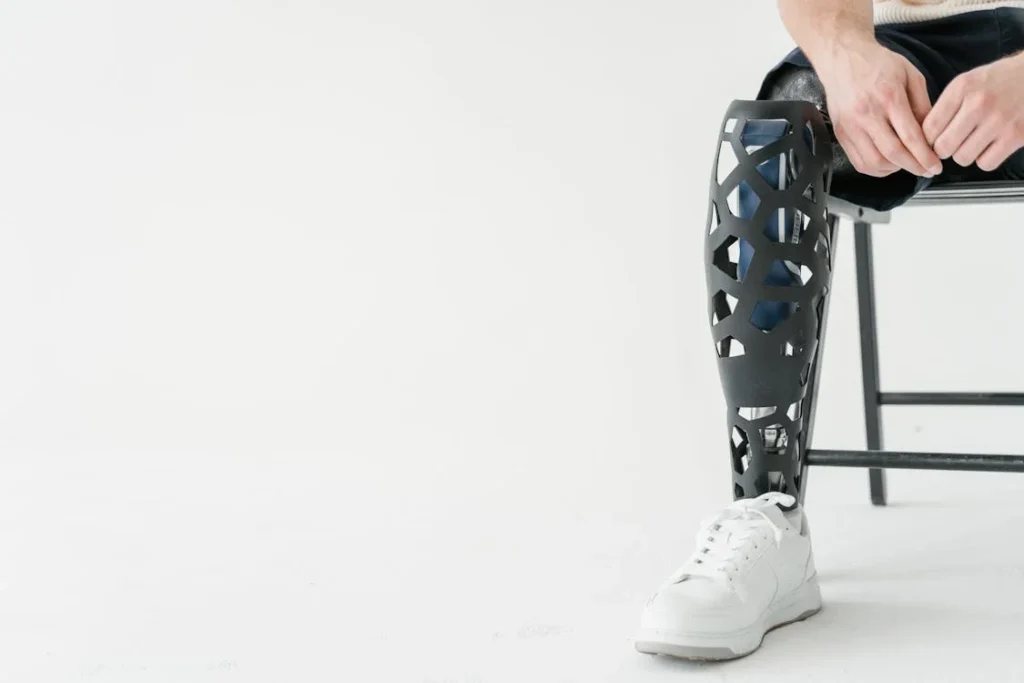
The Impact of Alignment on Joint Health
The Chain Reaction of Misalignment
The human body is a chain of connected parts. When one part is out of place, it affects the rest. In prosthetics, alignment acts like the foundation of a building. If the base isn’t level, the entire structure above it starts to shift.
With the body, that means the joints—ankle, knee, hip, and spine—end up compensating in ways that lead to long-term problems.
When a prosthetic is misaligned, the joints above or below it begin to work differently. For instance, if the prosthetic leg pushes the body forward slightly, the knee may hyperextend to balance things out. Over time, that added pressure wears down the cartilage inside the knee.
This can cause pain, swelling, and eventually lead to osteoarthritis. The same goes for the hip. A tilted alignment might cause one hip to lift higher than the other, which twists the spine and can lead to chronic back pain.
This isn’t something that happens overnight. Often, it starts with mild discomfort—maybe some soreness at the end of the day. But if ignored, those minor pains grow into daily stiffness, reduced range of motion, and a decrease in overall mobility.
By the time the damage is noticed, it can already be affecting quality of life.
Joint Protection Through Good Alignment
A properly aligned prosthetic, on the other hand, spreads out the mechanical load evenly across the joints. It supports the body in a way that feels natural. Each joint moves within its intended path, without overextending or grinding against surrounding tissue.
This helps prevent damage and reduces wear on the cartilage and ligaments.
The knee is one of the most vulnerable joints when alignment is poor. Every time we take a step, the knee absorbs a lot of force. When alignment is good, this force is balanced and controlled.
But with poor alignment, the force becomes uneven, placing too much pressure on the inner or outer part of the joint. This creates stress that the knee isn’t designed to handle.
The hips also suffer under misalignment, especially when someone adjusts their posture to make walking easier. A shifted pelvis can cause tightness in one side and overstretching in the other, leading to inflammation and pain.
Over time, the hip joint may become stiff or lose mobility, making walking more difficult.
Even the spine, which seems far removed from the prosthetic, can suffer. That’s because the spine works hard to keep us upright. When the lower body is off balance, the spine bends or rotates to compensate. This puts pressure on the discs and can lead to chronic back problems.
Alignment plays a silent, but powerful role in joint health. When it’s done correctly, it helps the body move efficiently, reduces stress on the joints, and keeps discomfort away.
The Importance of Regular Check-Ups
One of the most overlooked aspects of prosthetic alignment is the need for regular follow-up. Bodies change over time. Muscles get stronger or weaker. Weight shifts.
Habits develop. What worked a year ago may no longer be ideal today. That’s why it’s important for prosthetic users to get their alignment checked at regular intervals.
Many issues with joint pain start slowly and grow worse without warning. A user might get used to the discomfort, assuming it’s just part of using a prosthetic.
But in reality, a simple adjustment could solve the problem. Regular visits allow prosthetists to notice small changes and correct them before they lead to injury.
In some cases, even a small adjustment—just a few degrees or millimeters—can dramatically change how the joints respond to movement. These corrections help keep the body moving in a healthy pattern and reduce the long-term impact on bones and muscles.
Another thing to consider is that new prosthetic components often require fresh alignment. When a foot module is replaced, or a socket is refitted, the whole setup may need to be re-evaluated.
Just assuming the old alignment will still work can lead to poor performance and joint strain.
Prosthetic care isn’t something you do once and forget. It’s an ongoing part of maintaining a healthy, mobile life. Joint protection starts with alignment—and alignment starts with attention.
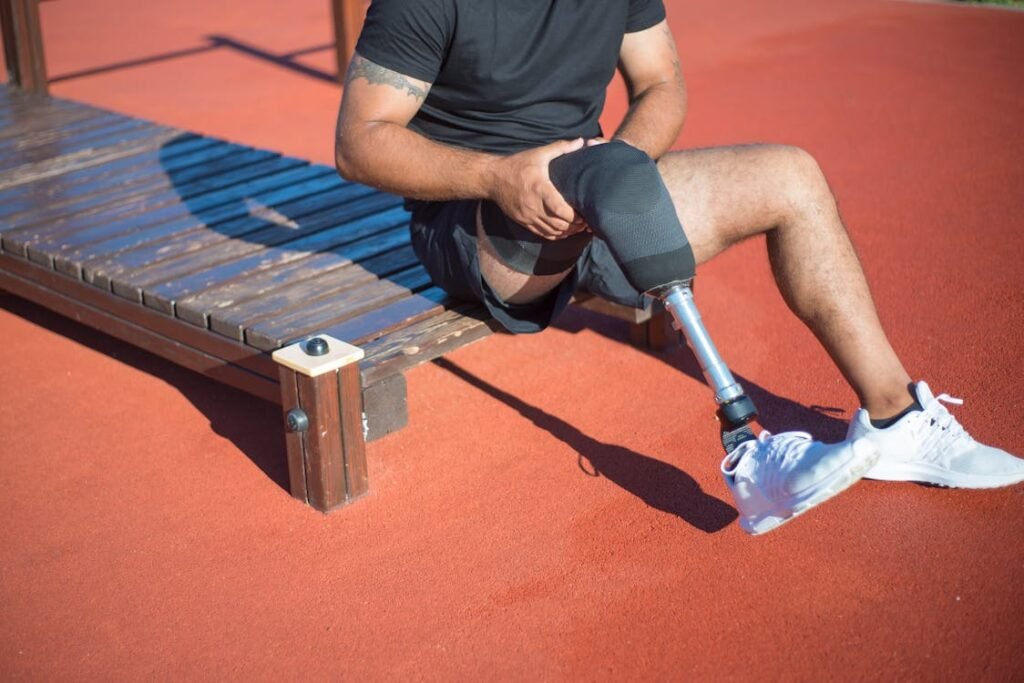
Personal Comfort and Long-Term Success
Listening to the Body
Living with a prosthetic is not just about function. It’s about how it feels. While much of the focus is often on walking or movement, personal comfort plays a huge role in whether someone continues to use their prosthetic with confidence.
Alignment directly affects this comfort. When everything is set up properly, the prosthetic feels like part of the body. Movements are smoother. Steps are easier. And the person feels less fatigued at the end of the day.
But the opposite is also true. Misalignment can create pressure points where the socket rubs too tightly. It can cause a pulling sensation on the skin, aching in the muscles, or pain in the joints.
These signs often show up quietly at first. A little irritation during a long walk. A bit of soreness when standing for too long. But they often grow worse with time.
The body always gives clues. It tells you when something doesn’t feel right. Listening to these signals is key to avoiding long-term problems. If walking feels harder than usual, or balance seems off, or there’s discomfort that wasn’t there before—these are all signs that alignment needs to be checked.
A person using a prosthetic should never feel like they’re fighting against their own body. Movement should feel natural and supportive. That’s why feedback is so important.
The user should feel free to talk about what they’re experiencing. Whether it’s pain, stiffness, or just something that feels “off,” sharing that information helps prosthetists make better decisions and improvements.
Emotional Well-being and Independence
When alignment is correct, the benefits go beyond the physical. There’s a deep emotional connection to being able to move freely, walk confidently, and go through the day without pain. That kind of independence builds self-esteem. It brings back a sense of control that’s often lost after limb loss.
Poor alignment, on the other hand, often leads to frustration. Simple tasks feel harder. The effort of moving around becomes mentally exhausting. Some users may begin to avoid social outings or public places, afraid of falling or feeling embarrassed.
That sense of freedom begins to shrink. But with good alignment and proper training, it’s possible to restore that freedom.
When someone can rely on their prosthetic to work with their body, not against it, their focus shifts from what they can’t do to what they can. They’re no longer thinking about every step. They’re living in the moment—walking, working, playing, and interacting like anyone else.
That emotional uplift, that renewed sense of possibility, comes from small, invisible technical details done well. Alignment might not be the flashiest part of prosthetics, but it’s one of the most important parts of feeling whole again.
Alignment Across Different Activities
People don’t just walk. They run, climb, sit, drive, and move in countless ways. Alignment needs to support all of those actions. A setup that feels perfect for standing or walking might not work as well when running or riding a bicycle. That’s why alignment often needs to be fine-tuned based on lifestyle.
Some users may need more flexibility in their foot or knee to help with sports. Others might need extra support if they spend long hours on their feet.
People who do a lot of bending, squatting, or stair climbing will need an alignment that supports those motions. No two lives are exactly the same, and no alignment should be either.
Prosthetic alignment isn’t a one-time event. It’s a continuous conversation between the user and the clinical team. As life changes, needs change.
And the prosthetic should adapt along with them. That might mean switching components, changing alignment angles, or adjusting the socket fit.
At Robobionics, we always encourage users to stay involved in their own care. Keep notes about how the prosthetic feels during different parts of the day. Notice patterns. Share those insights during check-ups. These small details help guide better decisions and better outcomes.

The Role of Technology in Alignment Precision
Advancements in Modern Tools
Prosthetic alignment has come a long way. In the past, it relied heavily on visual checks and trial-and-error adjustments. Today, advanced tools help make alignment more precise and personalized.
These tools don’t replace the skill of a trained prosthetist, but they do make the process faster, more accurate, and better for the user.
One of the most powerful tools is digital gait analysis. With the help of cameras, sensors, and motion-tracking software, professionals can watch how a user moves in real time and slow motion.
These tools reveal details that aren’t always visible to the human eye—how the foot hits the ground, how much weight goes through the knee, or how the hips rotate during walking. Every frame gives useful data that helps fine-tune alignment down to the smallest degree.
Pressure mapping systems are also valuable. These systems track how pressure is distributed inside the prosthetic socket or under the foot.
They show exactly where the body is absorbing the most force. If one spot is taking too much load, it may signal a problem with the alignment. Fixing that pressure point can reduce pain and protect the joints.
Even laser alignment tools help ensure that the prosthetic is placed at the correct angle and height. This is especially helpful during the early fitting process. It helps set a strong baseline, making sure the prosthetic is lined up correctly with the natural leg or arm.
At Robobionics, we believe that technology should support both comfort and confidence. That’s why we combine these advanced tools with patient feedback. It’s not just about numbers and graphs. It’s about how the person feels. Good data plus personal experience equals better results.
The Importance of Real-World Testing
Technology gives great insight in the clinic, but the real test is always in the real world. People don’t live their lives walking back and forth in a lab.
They walk on uneven sidewalks, climb stairs, carry bags, get in and out of cars. That’s why real-world testing is essential for finalizing alignment.
After the initial setup, users often go through a trial period. During this time, they wear the prosthetic in their daily routine. They come back with feedback.
Maybe the foot feels stiff on slopes. Maybe the knee feels unstable when turning. These real-life details guide the final adjustments that make the prosthetic truly functional.
This process is not rushed. It can take several weeks to fine-tune everything. That’s completely normal. Just like breaking in a new pair of shoes, the body needs time to adapt—and the prosthetic may need small tweaks along the way.
The goal is not just to walk. The goal is to move easily, safely, and confidently in every environment.
The Role of the User in the Alignment Process
Many people think that alignment is entirely the prosthetist’s job. But that’s only part of the story. The user plays an equally important role. They’re the ones wearing the prosthetic every day.
They’re the ones feeling the small shifts in comfort, pressure, and motion. Their input is vital.
That’s why open communication is so important. If something doesn’t feel right—even if it seems minor—it’s worth mentioning. What feels like a small discomfort now might turn into a bigger issue later.
By speaking up early, the prosthetist can make corrections before they become problems.
We always encourage users to ask questions. Understand what adjustments are being made and why. Know what to look out for. Keep track of how different activities feel. The more involved the user is, the more successful the alignment will be. It’s a team effort.
A well-informed user also gains more confidence. When you understand how your prosthetic works, how alignment affects your body, and how to notice small issues, you feel more in control. That confidence leads to better use, faster adaptation, and a smoother experience overall.
Staying Aligned Over Time: A Lifelong Journey
Adjusting as the Body Changes
The body is always changing. Muscle tone shifts. Weight can increase or decrease. Activity levels go up and down. And with these changes, the alignment of a prosthetic may need to change as well. What feels perfect today might not feel the same six months from now.
This is completely normal. In fact, it’s expected. For new users, changes often happen quickly as they get stronger and more active. The muscles around the residual limb may shrink or reshape.
As walking becomes easier, posture improves and new patterns develop. Each of these changes affects how the prosthetic should fit and move.
Even long-time users experience shifts. Aging, injuries, or changes in daily routine can all affect alignment. That’s why regular follow-ups with a prosthetist are so important.
These check-ins aren’t just for fixing problems. They’re for keeping things working at their best, even as life moves forward.
When alignment is seen as something flexible, not fixed, it becomes easier to manage comfort and health in the long term.
Preventing Issues Before They Begin
Proactive care is always better than reactive repair. By paying attention to small discomforts and responding early, users can avoid serious problems down the road. Catching a misalignment early can prevent pain, reduce joint wear, and stop falls before they happen.
It’s helpful to set up a regular review schedule with a prosthetic clinic, even if everything feels fine. Just like a car needs regular tuning to run smoothly, so does a prosthetic limb.
These visits might include small tests of walking, posture checks, and socket inspections. Often, a quick adjustment can improve performance more than expected.
At Robobionics, we support this approach by making our prosthetic services easy to access, whether through our own network or with partners like Omnify Prosthetics.
The goal is to remove the barriers between users and proper care. When support is local, fast, and responsive, users stay more active, healthier, and happier.
Independence Through Better Alignment
Alignment may seem like a technical subject, but it’s deeply connected to personal freedom. When a prosthetic is aligned properly, it disappears into the background.
It becomes something the user doesn’t have to think about. It moves naturally, supports the body silently, and gives back what was once lost—independence.
A good prosthetic lets people do more than walk. It lets them live fully. From going back to work, to playing with their kids, to moving through the world without fear or pain—these are the true goals. And alignment plays a quiet, essential part in making them possible.
No two bodies are alike. No two journeys with prosthetics are the same. But the path to a better life always begins with care, attention, and a commitment to doing things the right way. Alignment is not a small detail. It’s the foundation of success.
Conclusion
Prosthetic alignment is more than just adjusting parts. It’s about how the body moves, feels, and stays healthy over time. It affects every step you take, every joint in your body, and every goal you want to reach. When alignment is right, walking becomes smoother, balance becomes stronger, and pain becomes less frequent.
But alignment is not something that happens once. It’s a lifelong process. It changes as your life changes. That’s why staying involved in your own care, listening to your body, and speaking up about discomfort is so important. A small change today can protect your health and happiness for years to come.
At Robobionics, we see alignment as a partnership between science and humanity. We blend advanced tools with thoughtful listening. We focus on comfort, function, and long-term wellness. And most importantly, we walk alongside every user through every step of their journey.
Because when alignment is done right, life moves forward with confidence.



